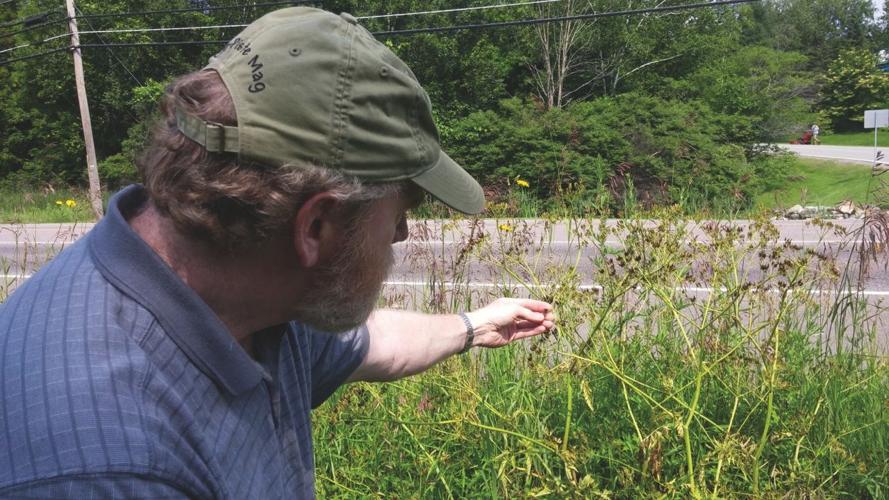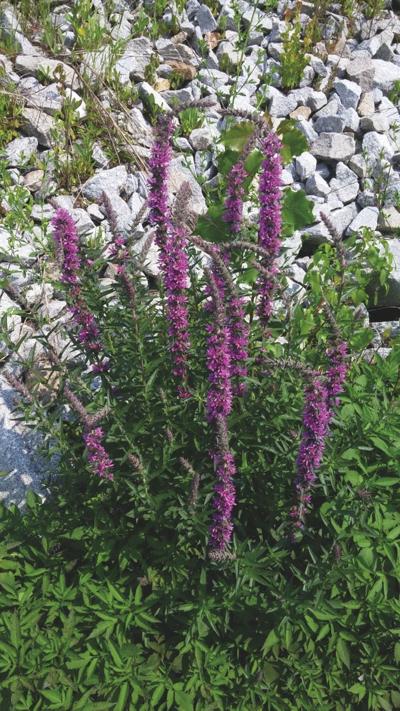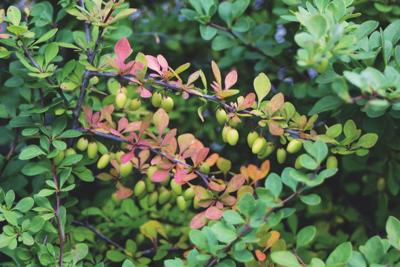Japanese knotweed is spreading along local riverbeds and roadsides faster than anyone can kill it, and it might be too late to get rid of it.
And knotweed is just the most prevalent in a horde of invading botanicals that are quickly moving in.
Joining the ubiquitous thick, viny, broad-leafed, ever-expanding blanket are more than a half dozen other invasive species — to the alarm of road crews, conservationists and backyard gardeners.
Wild chervil, wild parsnip and giant hogweed can burn your skin if you crack the stalk. Japanese barberry has thorns that can rapidly cover acres of woodland and poke users of once-passable trails and glades. Wild grapevines choke off plants, tangly bedstraw takes over pastures and is shunned by horses, and spearlike Phragmitis Australis can shoot up nearly 20 feet high in some places around the world.
And that’s key: “some places around the world” is now right in your backyard here in Vermont.
“With no natural predators to keep it in check, who knows how much of the landscape it’ll cover?” said Michael Hedges, a member of the Waterbury Conservation Commission and a longtime employee of the Vermont Agency of Transportation.
Hedges took a reporter on a tour this week of the roadsides and riverbanks along Route 100, pointing out more than a half-dozen invasive plant species that aren’t called Japanese knotweed — the most pervasive of them all.
“These other species keep taking over the landscape — that is, until knotweed takes over,” Hedges said.
Some of them, like tall, slender purple loosestrife, would look fabulous in your garden. And that’s exactly how they got to Vermont in the first place, by jumping out of the home gardener’s plot and into the wider world, said Caitrin Maloney, executive director of the Stowe Land Trust. Maloney said the Vermont state government has prohibited plant nurseries from selling certain “exotic invasives.”
Plenty of attention has been given to knotweed, the fast-growing plant that can grow up to 10 feet tall, and spread thick, tangly and quickly. But Hedges is on a mission to educate people about other invasives that line the roadways, particularly since that’s where his fellow VTrans workers spend a lot of their workdays.
“At VTrans, we have a people working in culverts, trimming roadside brush,” Hedges said. “Just working in the roads is hazardous enough, and now you’ve got to look out for this.”
Pretty, painful
Right about the time this story is hitting newsstands, drivers along Route 100 and other roads may notice bunches of delicate yellow flowers that resemble Queen Anne’s Lace. This plant is known as wild parsnip, and while it looks pretty, it can pack a painful sting.
Wild parsnips have fluids in their stalks that can burn the skin, irritate the lungs, and even cause blindness. The fluid is phototoxic, meaning it needs sunlight to activate it; depending on the amount and the type of plant from which it came, it can cause second-degree burns.
Wild parsnip is starting to bloom right now, just as a similar flower, wild chervil, is going to seed. Chervil looks similar to parsnip, but with white flowers and a slightly less potent sting. Now, the tops of the plants look like clusters of caraway seeds.
If you’re really unlucky, you might find yourself near some giant hogweed, another lacy white flower that would be like Queen Anne’s Lace if the famous queen were, well, a giant. Hogweed can grow to 15 feet in height, with stalks an inch in diameter. And inside that stalk? The most potent phototoxin in this area — something a roadside trimmer or backyard lawn mower will want to approach with long sleeves and pants, protective eye gear and face masks.
Getting rid of it
Mowing the plants down can just spray the seeds, rhizomes or other parts of the plant in a wider area.
Sometimes road crews will spread the plants far and wide through tainted loads of dirt and gravel they spread on roads.
Birds will eat the berries and seeds of some plants and deposit them in their droppings.
The river and winds can take seeds and spores far and wide.
Short of spraying pesticides all over the place — a practice not recommended, and even outright banned in some cases — the best way to get rid of invasive species is by getting rid of the root system. Stowe Land Trust and the Nature Conservancy encourage hikers and bikers to pull up the roots of invasives whenever they can, and dispose of them.
If you’re unsure about a plant, take a cutting to them or a local forester, who might be able to identify it for you.
Some invasives are edible, but not even a legion of hungry Vermonters could eat their way out of this problem.
“You can definitely spread it around pretty easily, and the rivers and roadways are vectors for getting it around the environment,” said Kristen Sharpless, conservation program manager with the land trust.
Japanese barberry
One particularly prickly plant is giving Stowe conservationists and recreationalists a tough time. Japanese barberry is a shrub with spatula-shaped leaves, red fruit, yellow flowers hanging below the stem, and a single spine at each leaf base.
It is green at this time of the year, but the vines and stems turn a striking, deep orange in the fall.
It is quickly infiltrating Cady Hill Forest, a Land Trust-conserved parcel that is home to some of Stowe’s most popular mountain bike and hiking trails.
“We were surprised at how far into the woods it had spread already,” Sharpless said. “It’s tricky in how to manage it, because once you notice it, it’s already pretty far advanced.”
Not only is it unpleasant to walk through, but barberry and other non-native exotic plants bring along unwanted visitors: Lyme disease-spreading deer ticks.
“Deer tick populations are something like 100 times more prevalent” within the new acreage of invasives, Sharpless said.





(1) comment
Akin to the invasive Vermont politics started by "Brooklyn Bernie" Sanders. We are doomed!
Welcome to the discussion.
Log In
Keep it clean. Please avoid obscene, vulgar, lewd, racist or sexual language.
PLEASE TURN OFF YOUR CAPS LOCK.
Don't threaten. Threats of harming another person will not be tolerated.
Be truthful. Don't knowingly lie about anyone or anything.
Be nice. No racism, sexism or any sort of -ism that is degrading to another person.
Be proactive. Use the "Report" link on each comment to let us know of abusive posts.
Share with us. We'd love to hear eyewitness accounts, the history behind an article.